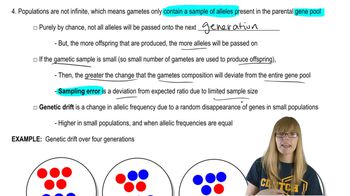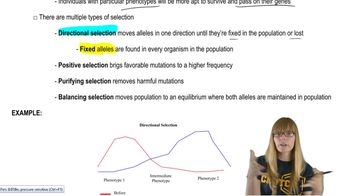Table of contents
- 1. Introduction to Genetics51m
- 2. Mendel's Laws of Inheritance3h 37m
- 3. Extensions to Mendelian Inheritance2h 41m
- 4. Genetic Mapping and Linkage2h 28m
- 5. Genetics of Bacteria and Viruses1h 21m
- 6. Chromosomal Variation1h 48m
- 7. DNA and Chromosome Structure56m
- 8. DNA Replication1h 10m
- 9. Mitosis and Meiosis1h 34m
- 10. Transcription1h 0m
- 11. Translation58m
- 12. Gene Regulation in Prokaryotes1h 19m
- 13. Gene Regulation in Eukaryotes44m
- 14. Genetic Control of Development44m
- 15. Genomes and Genomics1h 50m
- 16. Transposable Elements47m
- 17. Mutation, Repair, and Recombination1h 6m
- 18. Molecular Genetic Tools19m
- 19. Cancer Genetics29m
- 20. Quantitative Genetics1h 26m
- 21. Population Genetics50m
- 22. Evolutionary Genetics29m
21. Population Genetics
Allelic Frequency Changes
Problem 28
Textbook Question
The original source of new alleles, upon which selection operates, is mutation, a random event that occurs without regard to selectional value in the organism. Although many model organisms have been used to study mutational events in populations, some investigators have developed abiotic molecular models. Soll et al. (2006. Genetics 175: 267-275) examined one such model to study the relationship between both deleterious and advantageous mutations and population size in a ligase molecule composed of RNA (a ribozyme). Soll found that the smaller the population of molecules, the more likely it was that not only deleterious mutations but also advantageous mutations would disappear. Why would population size influence the survival of both types of mutations (deleterious and advantageous) in populations?
 Verified step by step guidance
Verified step by step guidance1
<span>Understand the concept of genetic drift: In small populations, random events can have a larger impact on allele frequencies, leading to genetic drift. This means that alleles, whether advantageous or deleterious, can be lost purely by chance.</span>
<span>Consider the role of selection: In larger populations, natural selection can more effectively increase the frequency of advantageous mutations and decrease the frequency of deleterious ones. However, in smaller populations, the effect of selection is weaker compared to genetic drift.</span>
<span>Analyze the impact of population size: In small populations, the random loss of alleles due to genetic drift can overshadow the effects of natural selection, leading to the disappearance of both advantageous and deleterious mutations.</span>
<span>Explore the concept of fixation: In small populations, alleles can become fixed (reach a frequency of 1) or lost (reach a frequency of 0) more quickly due to genetic drift, regardless of their selective advantage or disadvantage.</span>
<span>Relate to the study by Soll et al.: The study suggests that in small populations of ribozymes, both advantageous and deleterious mutations are more likely to disappear due to the stronger influence of genetic drift compared to selection.</span>
Recommended similar problem, with video answer:
 Verified Solution
Verified SolutionThis video solution was recommended by our tutors as helpful for the problem above
Video duration:
4mPlay a video:
Was this helpful?
Key Concepts
Here are the essential concepts you must grasp in order to answer the question correctly.
Mutation
Mutation is a change in the DNA sequence of an organism's genome, which can lead to the creation of new alleles. These changes can occur randomly and can be caused by various factors, including environmental influences or errors during DNA replication. Mutations are essential for evolution as they provide the genetic variation upon which natural selection acts.
Recommended video:
Guided course

Mutations and Phenotypes
Population Size and Genetic Drift
Population size significantly affects genetic drift, a mechanism of evolution that describes how allele frequencies fluctuate due to random sampling effects. In smaller populations, random events can lead to the loss of alleles, including both deleterious and advantageous mutations, more rapidly than in larger populations. This can result in reduced genetic diversity and impact the population's ability to adapt to environmental changes.
Recommended video:
Guided course

Genetic Drift
Natural Selection
Natural selection is the process by which certain traits become more or less common in a population based on their impact on survival and reproduction. Advantageous mutations may confer benefits that enhance an organism's fitness, while deleterious mutations can reduce it. The effectiveness of natural selection is influenced by population size, as smaller populations may not effectively retain beneficial mutations due to higher rates of genetic drift.
Recommended video:
Guided course

Natural Selection

 5:58m
5:58mWatch next
Master Natural Selection with a bite sized video explanation from Kylia Goodner
Start learning


